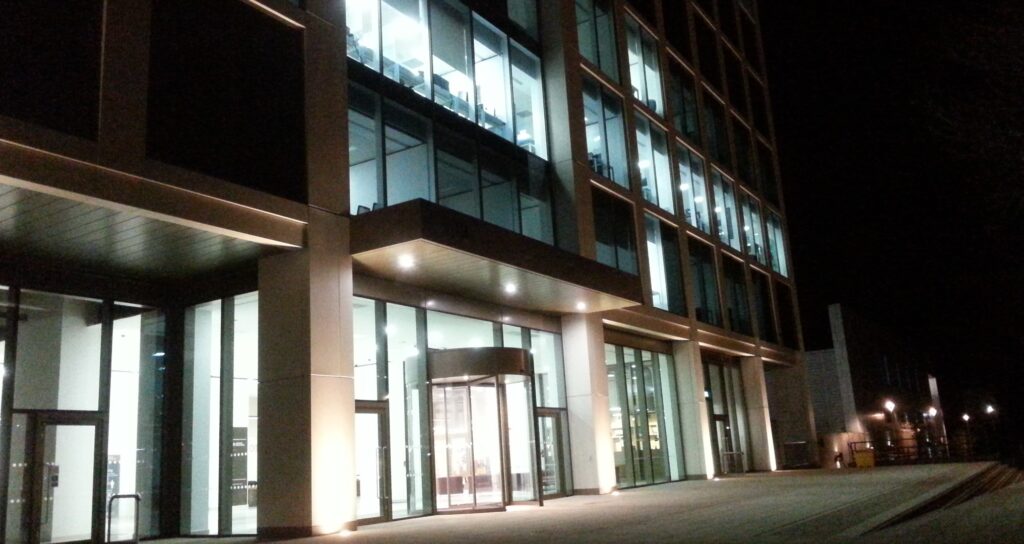I’ve recently moved into a new office. You might hope, nay expect, that I would have undertaken a detailed environmental appraisal of the benefits and carefully weighed up my new ecological footprint. No, hardly at all! In that, I am like everyone else – it’s location, location, location (and the availability of decent coffee).

Actually I am probably doing myself a disservice. The move was forced upon me – two working days before Christmas my office provider (I won’t name them, but they’re the global number 1 in their market) told me they had been unable to negotiate a new superior lease (ie. hadn’t been able to reduce what they were paying enough), so we were all being moved, and I was given a (very) shortlist of options. And here it did boil down to location, location or location. One had a view across a local park – but was next to a motorway junction, hard to reach by bus and had a free car park I might be tempted to use. The second was in the city centre, close to my former office, but was a windowless cell (although it was above a leading craft brewery outlet). And the third was in a new building, close to the railway station with the promise of secure covered cycle parking (and a branch of Pret two minutes’ walk away). The station one won. Once this pandemic has survived (and even I, the perennial pessimist, believe that it must eventually) I will want to be back down to London for F2F meetings and energy/carbon audits.
So I then started trying to find the new office’s environmental credentials. It’s a newbuild, but on a brownfield site – even Milton Keynes has brownfield sites, as the lifespan of commercial building developments can be frustratingly short. I can remember taking my son to bowling birthday parties in the Leisure Plaza – I may even have once scored a strike there! But although it had only opened in 1990, the bowling alley was demolished around 2014 and, phoenix-like, a seven storey office complex has risen in its place.
 The first thing was to find its Energy Performance Certificate (EPC). These are now centrally lodged in a corner of the gov.uk website and – as with most parts of the site – are less informative than they were before. Although this reveals that it has a rating of B26 (better than the D71 of the old office), the assessor who undertook the rating is no longer named. That’s a pity, as I would have liked to ask him/her how the certificate can simultaneously show that it has no air-conditioning (“Aircon Present No”), but that the main contributor or servicing strategy that contributes to the building’s emissions is “Air Conditioning”:
The first thing was to find its Energy Performance Certificate (EPC). These are now centrally lodged in a corner of the gov.uk website and – as with most parts of the site – are less informative than they were before. Although this reveals that it has a rating of B26 (better than the D71 of the old office), the assessor who undertook the rating is no longer named. That’s a pity, as I would have liked to ask him/her how the certificate can simultaneously show that it has no air-conditioning (“Aircon Present No”), but that the main contributor or servicing strategy that contributes to the building’s emissions is “Air Conditioning”:

A little bit of digging shows that there is full air conditioning and the building has 15 Daikin VRV systems, essentially two per floor, and a control system that enables billing by floor, rather than simply dividing it on square footage. What this means for air quality in a time of COVID is anyone’s guess. I am, of course, WfH at the moment, so cannot yet say whether the ventilation strategy will work, especially in summer, as the building has large glazed areas. Unlike my previous office, there is no gas, so the hot water for toilets comes from air source heat pumps, although hot water for the sinks adjacent to the coffee stations installed by my immediate landlord appears to come from an instantaneous electric source. Like many offices, externally it appears as a sealed glazed box. Although this could set alarm bells ringing, Saint-Gobain feature it on their website:
Saint-Gobain COOL-LITE XTREME 50/22 was selected for the large expanses of floor to ceiling glazing and the 10 metre height, glazed reception, due to the products very high selectivity of 2.24 (ratio of visible light to solar heat gain). The product performance values maximise light transmission whilst reducing the need for expensive and non-eco-friendly air conditioning; perfect for this sustainable and low energy BREEAM accredited building.
That is hopeful at least; but I shall miss the ability to open a window that we had in my previous office (quite apart from the fact that I am now wholly internal). And it’s only just over a year since the windows in my previous office were replaced and we had to fight hard to get the landlord to replace like for like with opening windows.
Good light transmission may also encourage natural use of daylight, although again for an internal office this is difficult. Indeed the lighting strategy seems to be wholly automated – when I walk into my office the light comes on, whether I want it or not, and stays on for a period of time after I leave. As I have only made one pre-lockdown visit, I cannot say how well this will work – or how sensitive to movement it will be. I’m also unsure if the same strategy is used for those lucky enough to have external windows (and to benefit from that Cool-lite Xtreme glazing). I have a nagging suspicion that this may have been influenced as much by a desire to eliminate the need to install light switches during the fit-out, as there are only fully glazed panels within reach of the door. Equally, I can’t tell if corridor lights stay on 24/7 or if they are on a motion/daylight sensor combination.
Saint-Gobain’s press release also mentions BREEAM, the leading assessment scheme for green buildings. The offices appear to have achieved a “Very Good” rating, although are not shown on the BREEAM website map; while this might sound very good, there are two higher levels of achievement (excellent and outstanding). This is perhaps a little unfair, though, as only a handful of buildings in Milton Keynes have better ratings and it is not easy to obtain a Very Good certificate.
BREEAM is not just about energy though, and includes a scoring for transport links. The new building is let down perhaps by including an internal multi-storey car park, although with on car space for 545ft2 of floor area, provision is quite sparse. More desirably, it apparently includes 12 EV charging spaces and 100 secure cycle parking spaces – all I have to do is find out where they are! And of course, being 3 minutes’ walk from the main Milton Keynes Central railway station (and bus interchange) is a definite bonus, and there are plenty of public cycle hire points just outside the station, as well as dockless eBikes and eScooters in the vicinity.
